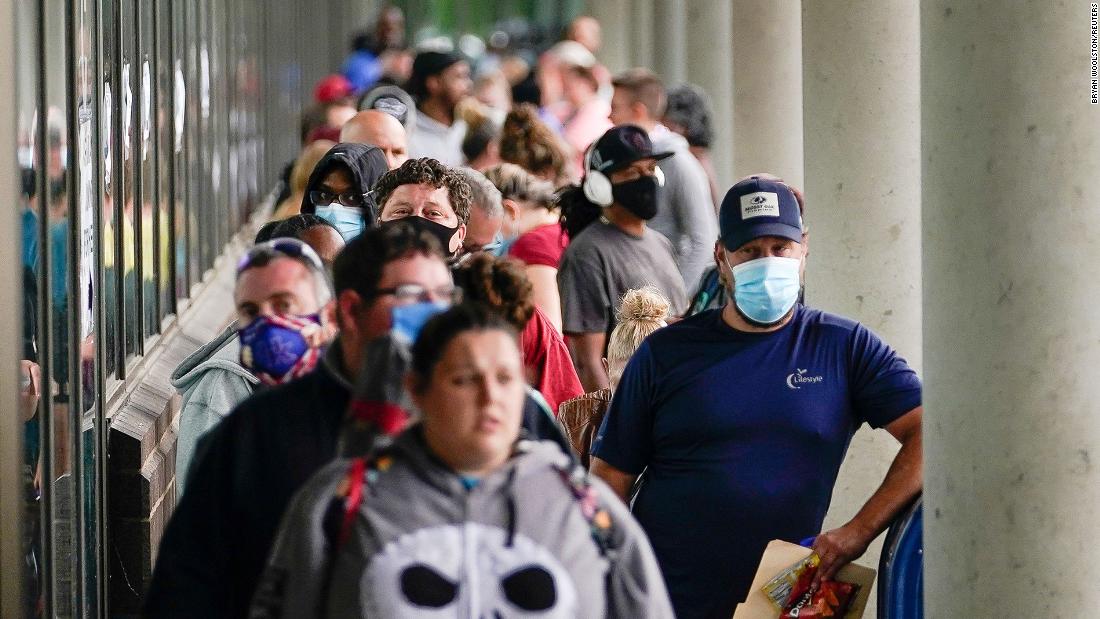
Another 1.3 million people filed first-time claims for unemployment aid on a seasonally-adjusted basis last week, according to the Department of Labor. That's down 99,000 claims from the prior week's revised level.
But the story doesn't look quite so good without the seasonal adjustment. These adjustments are used to smooth out the data in normal times. But during the pandemic, they tend to accomplish the opposite. On an unadjusted basis, 1.4 million people filed first-time claims, a decrease of some 32,000 people from the week before.
In addition to those filing for traditional benefits, just over 1 million people in 49 states claimed first-time pandemic unemployment assistance last week, about 42,000 more than the week before.
The program, created by Congress in late March to respond to the coronavirus outbreak, temporarily provides benefits to workers who typically aren't eligible for payments, including freelancers, independent contractors, the self-employed and certain people affected by the coronavirus.
Weekly jobless claims have been falling for more than three months since their peak in the last week of March. That's a good sign, because it means fewer people are finding themselves newly in need for benefits. But the claims remain stubbornly high and aren't trending downward as quickly as economists would like.
Weekly claims were never in the ballpark of one million before the pandemic.
Continued claims, which count workers who have filed claims for at least two weeks in a row, stood at 18.1 million. Meanwhile, nearly 14.4 million people claimed continued pandemic benefits across 47 states. That's up just over 1.5 million from the prior week. The pandemic program is set to expire at the end of the year.
Economists have shifted their focus to continued claims earlier this summer, saying it's a better indicator of how many people are returning to work versus staying on benefits. But again the number is trending down slowly, and that doesn't bode well for the economic recovery.
On top of that, many states have paused their economic reopening schedules following a rise in Covid-19 infections. That might keep people at home for longer, when they would have otherwise returned to work in later reopening phases.
The Federal Reserve Bank of Atlanta's latest CFO survey found that the average surveyed business didn't expect to get back to its pre-pandemic employment level until the end of 2021.
Tallying up all workers filing claims under traditional and pandemic unemployment porgrams, as well as the pandemic emergency unemployment compensation program, nearly 33 million Americans claimed jobless benefits. This also includes nearly 360,000 people in the short-time compensation/workshare program, which is designed to avoid layoffs by allowing employers to reduce workers' hours and permit employees to claim partial unemployment benefits.
Lawmakers created pandemic compensation program -- which had more than 850,000 filers -- to provide those who have exhausted their benefits with an additional 13 weeks of payments. It also expires at the end of 2020.
Paying for a jobless crisis
Meanwhile, a growing number of states' unemployment trust funds have run dry, forcing them to borrow from the federal government to pay their share of weekly benefits, which typically last 26 weeks.
Eight states have now tapped the Treasury Department for loans, totaling nearly $10 billion over the last few months. California and New York have the largest balances at nearly $3.8 billion and $3.7 billion respectively, as of July 7.
These two states -- as well as Illinois, Kentucky, Massachusetts, Ohio, Texas and West Virginia -- have borrowed a total of nearly $3 billion just in the first week of July.
Altogether, 12 states have been authorized to borrow up to $17.5 billion this month, but Colorado, Delaware, Hawaii and Minnesota have yet to ask for funds.
Thirteen states have asked permission to borrow $45 billion between June and August to pay benefits, as of mid-June, according to the Department of Labor. Several already increased the requested authorization for July.
It's not uncommon for states to turn to the federal government for help paying claims during economic downturns. The jobless are guaranteed to receive their benefits regardless of whether states have the funds on hand to pay.
While states are responsible for their weekly benefit, the federal government is picking up the tab for the temporary enhancement to the unemployment program that Congress passed in late March. The historic expansion includes a $600 weekly boost to payments, which ends later this month unless lawmakers extend it, as well as a 13-week extension of benefits and a broadening of the program to cover freelancers, independent contractors, the self-employed and certain people affected by coronavirus, both of which run out at the end of the year.
In addition, the swift spike in unemployment rates has triggered the extended benefit program in all states except South Dakota. This provides the jobless with an additional 13 weeks or 20 weeks of payments, depending on where they live. This extension takes effect after state benefits and the federal extension run out.
Typically, states and the federal government split the cost, but the federal government will cover the full amount through the end of 2020, under a coronavirus relief package Congress passed in mid-March.
"still" - Google News
July 09, 2020 at 08:26PM
https://ift.tt/2O9dHw7
Unemployment claims are falling. But 1.3 million still applied for assistance last week - CNN
"still" - Google News
https://ift.tt/35pEmfO
https://ift.tt/2YsogAP
Bagikan Berita Ini














0 Response to "Unemployment claims are falling. But 1.3 million still applied for assistance last week - CNN"
Post a Comment